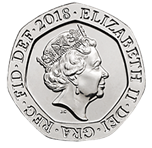
The British decimal twenty pence coin is a denomination of sterling coinage worth 1⁄5 of a pound. Like the 50p coin, it is an equilateral curve heptagon. Its obverse has featured the profile of Queen Elizabeth II since the coin's introduction on 9 June 1982. Four different portraits of the Queen have been used; the latest design by Jody Clark was introduced in 2015. The second and current reverse, featuring a segment of the Royal Shield, was introduced in 2008.
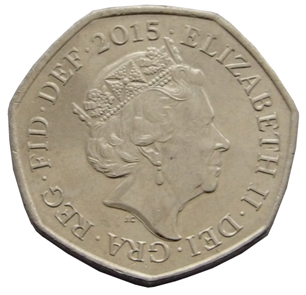
The British decimal fifty pence coin is a denomination of sterling coinage worth 1⁄2 of one pound. Its obverse has featured the profile of the current Monarch since the coin's introduction in 1969. As of November 2024, six different royal portraits have been used.
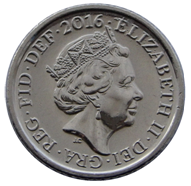
The British decimal five pence coin is a denomination of sterling coinage worth 5⁄100 of a pound. Its obverse has featured the profile of Queen Elizabeth II since the coin’s introduction on 23 April 1968, replacing the shilling in preparation for decimalisation in 1971. It remained the same size as the one shilling coin, which also remained legal tender, until a smaller version was introduced in June 1990 with the older coins being withdrawn on 31 December 1990. Four different portraits of the Queen have been used, with the latest design by Jody Clark being introduced in 2015. The second and current reverse, featuring a segment of the Royal Shield, was introduced in 2008.

The British decimal ten pence coin is a denomination of sterling coinage worth 1⁄10 of a pound. Its obverse has featured the profile of Queen Elizabeth II since the coin's introduction in 1968, to replace the florin coin in preparation for decimalisation in 1971. It remained the same size as the florin until a smaller version was introduced on 30 September 1992, with the older coins being withdrawn on 30 June 1993. Four different portraits of the Queen have been used on the coin; the latest design by Jody Clark was introduced in 2015. The second and current reverse, featuring a segment of the Royal Shield, was introduced in 2008.

The British decimal one penny (1p) coin is a unit of currency and denomination of sterling coinage worth 1⁄100 of one pound. Its obverse featured the profile of Queen Elizabeth II since the coin's introduction on 15 February 1971, the day British currency was decimalised, until her death on 8 September 2022. A new portrait featuring King Charles III was introduced on 30 September 2022, designed by Martin Jennings. Four different portraits of the Queen were used on the obverse; the last design by Jody Clark was introduced in 2015. The second and current reverse, designed by Matthew Dent, features a segment of the Royal Shield and was introduced in 2008. The penny is the lowest value coin ever to circulate in the United Kingdom.

The British decimal two pence coin is a denomination of sterling coinage equalling 2⁄100 of a pound. Since the coin's introduction on 15 February 1971, the year British currency was decimalised, its obverse has featured four profiles of Queen Elizabeth II. In 2008 the design on its reverse changed from the original depiction of a plume of ostrich feathers with a coronet to a segment of the Royal Shield.

The British two pound coin (£2) is a denomination of sterling coinage. Its obverse has featured the profile of Queen Elizabeth II since the coin’s release. Three different portraits of the Queen have been used, with the current design by Jody Clark being introduced in 2015. The reverse design features Britannia.

The British one pound (£1) coin is a denomination of sterling coinage. Its obverse bears the Latin engraving ELIZABETH II D G REG F D meaning, 'Elizabeth II, by the grace of God, Queen, Defender of the Faith'. It has featured the profile of Queen Elizabeth II since the original coin's introduction on 21 April 1983. Four different portraits of the Queen have been used, with the latest design by Jody Clark being introduced in 2015. The design on the reverse side of the current, 12-sided coin features four emblems to represent each of the nations of the United Kingdom — the English rose, the leek for Wales, the Scottish thistle, and the shamrock for Northern Ireland, also two or three oak leaves — emerging from a single 5-branched stem within a crown. In May 2022 the Royal Mint announced that the Kenyan-born artist Michael Armitage is designing a new £1 coin which will be issued in 2023 and will celebrate the "history of the UK in the 21st century".
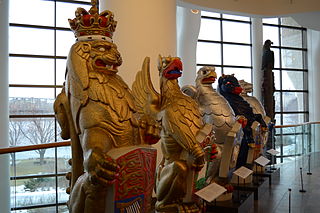
The Queen's Beasts are ten heraldic statues representing the genealogy of Queen Elizabeth II, depicted as the Royal supporters of England. They stood in front of the temporary western annexe to Westminster Abbey for the Queen's coronation in 1953. Each of the Queen's Beasts consists of a heraldic beast supporting a shield bearing a badge or arms of a family associated with the ancestry of Queen Elizabeth II. They were commissioned by the British Ministry of Works from the sculptor James Woodford, who was paid the sum of £2,750 for the work. They were uncoloured except for their shields at the coronation. They are now on display in the Canadian Museum of History in Gatineau, Quebec.
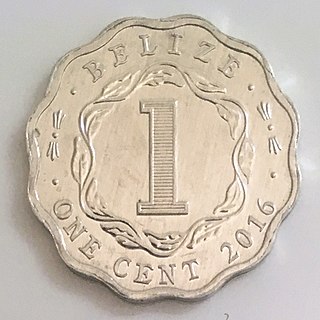
On June 1, 1973, the British colony of British Honduras changed its name to Belize, but its status remained unchanged until 1981, when Belize was granted independence.

The twelve-sided Australian fifty-cent coin is the third-highest denomination coin of the Australian dollar and the largest in terms of size in circulation. It is equal in size and shape to the Cook Island $5 coin, and both remain the only 12-sided coins in the southern hemisphere. It was introduced in 1969 to replace the round fifty-cent coin issued in 1966.
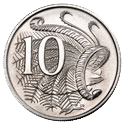
The Australian ten-cent coin is a coin of the decimal Australian dollar. When the dollar was introduced as half of an Australian pound on 14 February 1966, the coin inherited the specifications of the pre-decimal shilling; both coins were worth one twentieth of a pound and were called "bob". On introduction it was the fourth-lowest denomination coin. Since the withdrawal from circulation of the one and two cent coins in 1992, it has been the second-lowest denomination coin in circulation.
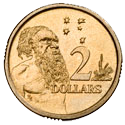
The Australian two-dollar coin is the highest-denomination circulating coin of the Australian dollar. It was first issued on 20 June 1988, having been in planning since the mid-1970s. It replaced the Australian two-dollar note due to having a longer circulatory life. The only "mint set only" year was 1991.

The cent, formally the one-cent coin, was the lowest-denomination coin of the Australian dollar. It was introduced on 14 February 1966 in the decimalisation of Australian currency and was withdrawn from circulation in 1992. It is still minted as a non-circulating coin. A one-cent coin in 1966 would have a purchasing power equal to about 16c in 2023 values.
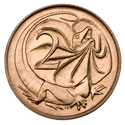
The Australian two-cent coin was introduced in 1966 and was the coin of the second-lowest denomination until it was withdrawn from circulation in 1992. It is still counted as legal tender, but is subject to some restrictions, and two-cent coins are legal tender only up to the sum of 20 cents.

The New Zealand one-dollar coin ($1) is a coin of the New Zealand dollar. The current circulating coin was introduced on 11 February 1991 to replace the existing $1 note. There had previously been occasional issues of commemorative "silver dollars", but they are rarely seen in circulation.

Tower Mint was founded in 1976 by acclaimed sculptor Raphael Maklouf and has become one of the leading private mints in the UK and the last remaining mint in London.
The New Zealand two-dollar coin is the largest-denomination coin of the New Zealand dollar. It was introduced along with the one-dollar coin in 1990. Both are made from an alloy of aluminium and brass. It is the largest and heaviest coin in circulation, weighing ten grams and measuring 26.5 millimetres in diameter. Its thickness is 2.7 mm, only 0.4 mm thinner than the one-dollar coin, thus it is the second-thickest coin in the country's circulation. Both the $1 and $2 coins are gold-coloured, and requests for a Koha, donation or entry fee sometimes say gold coin please.
The New Zealand fifty-cent coin is a coin of the New Zealand dollar. It was the largest by denomination, diameter and mass to have been introduced on the decimalisation of the currency on 10 July 1967, replacing the pre-decimal crown coin. A total of 81,585,200 pre-2006 50 cent coins were issued, with a total value of $40,792,600.00
The New Zealand two-cent coin was the second smallest denomination coin of the New Zealand dollar from the currency's introduction in 1967 to its demonetisation, along with the one-cent coin, on 30 April 1990. Its reverse featured two kōwhai flowers, considered emblematic of New Zealand. The image was designed by Reginald George James Berry, who designed the reverses for all coins introduced that year.
















